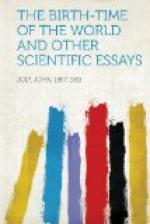It is probable, that to conditions of structural development, under the influence of natural selection, the question of longer or shorter life is in a great degree referable. Thus, development along lines of large growth will tend to a slow rate of reproduction from the simple fact that unlimited energy to supply abundant reproduction is not procurable, whatever we may assume as to the strength or cunning exerted by the individual in its efforts to obtain its supplies. On the other hand, development along lines of small growth, in that reproduction is less costly, will probably lead to increased rate of reproduction. It is, in fact, matter of general observation that in the case of larger animals the rate of reproduction is generally slower than in the case of smaller animals. But the rate of reproduction might be expected to have an important influence in determining the particular periodicity of the organism. Were we to depict in the last diagram, on the same time-scale as Man, the vibrations of the smaller and shorter-lived living things, we would see but a straight line, save for secular variations in activity, representing the progress of the species in time: the tiny thrills of its units lost in comparison with the yet brief period of Man.
The interdependence of the rate of reproduction and
93
the duration of the individual is, indeed, very probably revealed in the fact that short-lived animals most generally reproduce themselves rapidly and in great abundance, and vice versa. In many cases where this appears contradicted, it will be found that the young are exposed to such dangers that but few survive (e.g. many of the reptilia, etc.), and so the rate of reproduction is actually slow.
Death through the periodic rigour of the inanimate environment calls forth phenomena very different from death introduced or favoured by competition. A multiplicity of effects simulative of death occur. Organisms will, for example, learn to meet very rigorous conditions if slowly introduced, and not permanent. A transitory period of want can be tided over by contrivance. The lily withdrawing its vital forces into the bulb, protected from the greatest extremity of rigour by seclusion in the Earth; the trance of the hibernating animal; are instances of such contrivances.
But there are organisms whose life-wave truly takes up the periodicity of the Earth in its orbit. Thus the smaller animals and plants, possessing less resources in themselves, die at the approach of winter, propagating themselves by units which, whether egg or seed, undergo a period of quiescence during the season of want. In these quiescent units the energy of the organism is potential, and the time-energy function is in abeyance. This condition is, perhaps, foreshadowed in the encyst-
94




